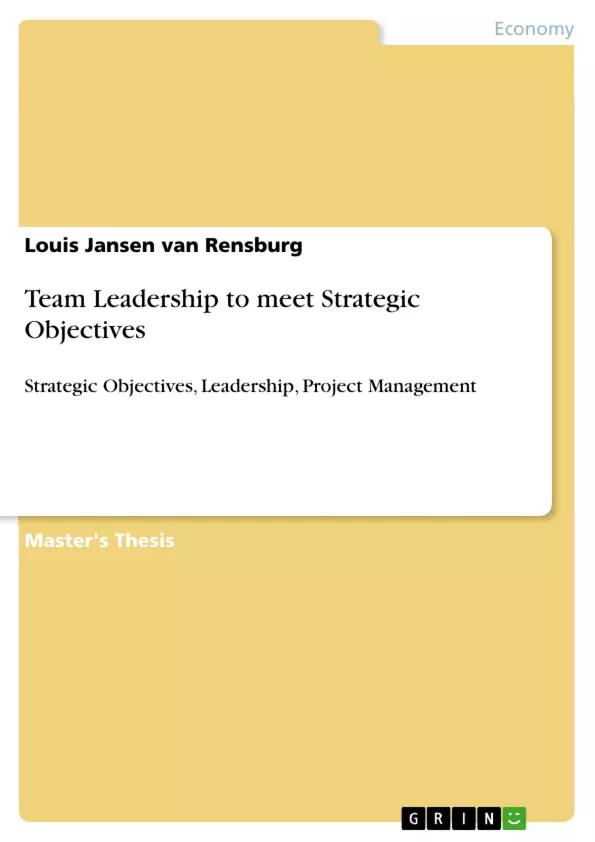Team leadership has always been at the epicentre, the heart of any company wishing to meet strategy objectives. Working in an environment where teams function cross-functionally, functional centricity can become the turf and playground that obstruct and eliminate objectives for strategic intent. To enable a shared vision which meet strategy objectives this research study has examined a core sample of team leaders who provided leadership of their various teams. Given a competency to which level all leaders conformed in their managerial capacity to lead teams, eleven team leaders were evaluated with regard to key competency characteristics involving empathy, feedback, leadership capacity, commitment, performance, empowerment, communication, motivation and influence. The respondent teams were assessed on their maturity level and a Tuckman plot was compiled to measure each team’s maturity level in the organisation as well as each team’s competency characteristic dimensions which consisted of the following:
- Absence of trust.
- The fear of conflict.
- The lack of commitment.
-The avoidance of accountability; and
- Inattention to results.
To move from a good to even a great team performance, characterising a high-performance team with an impressive team leader, measurement is needed to pin-point the level at which the assessed company is currently performing, in order to validate and plan future long-term, winning strategies.
Inhaltsverzeichnis (Table of Contents)
- Abstract
- Glossary of Terms
- Chapter 1: Introduction
- 1.1 Introduction
- 1.2 Background and Context
- 1.3 Statement of the Problem
- 1.4 Research Objectives
- 1.5 Research Questions
- 1.6 Significance of the Study
- 1.7 Scope and Delimitations of the Study
- 1.8 Theoretical Framework
- 1.9 Conceptual Framework
- 1.10 Methodology
- Chapter 2: Literature Review
- 2.1 Introduction
- 2.2 Theoretical Perspective of Teams and Team Leadership
- 2.2.1 Group Development Theories
- 2.2.2 Team Leadership Theories
- 2.2.3 Team Performance and Effectiveness
- 2.3 Empirical Research Findings
- 2.3.1 Team Leadership Styles and Team Performance
- 2.3.2 The Role of Communication in Team Leadership
- 2.3.3 The Impact of Diversity on Team Leadership
- 2.3.4 The Influence of Culture on Team Leadership
- 2.4 Gaps in the Existing Literature
- Chapter 3: Research Methodology
- 3.1 Introduction
- 3.2 Research Design
- 3.2.1 Qualitative Research Approach
- 3.2.2 Case Study Methodology
- 3.3 Population and Sample
- 3.3.1 The Case Study Organisation
- 3.3.2 Participants
- 3.4 Data Collection Methods
- 3.4.1 Interviews
- 3.4.2 Questionnaires
- 3.4.3 Observations
- 3.5 Data Analysis Methods
- 3.5.1 Thematic Analysis
- 3.5.2 Quantitative Analysis
- 3.5.3 Tuckman Plot
- 3.6 Ethical Considerations
- 3.7 Limitations of the Study
- Chapter 4: Data Analysis and Findings
- 4.1 Introduction
- 4.2 Team Leader Competencies
- 4.3 Team Maturity Levels
- 4.4 Team Competency Characteristic Dimensions
- 4.5 The Relationship Between Team Leadership and Team Performance
- 4.6 The Impact of Team Leadership on Strategic Objectives
- Chapter 5: Discussion and Conclusion
Zielsetzung und Themenschwerpunkte (Objectives and Key Themes)
This dissertation aims to investigate the relationship between team leadership and the attainment of strategic objectives within a corporate environment. The study examines the effectiveness of team leaders in guiding their teams towards organizational success. It explores the interplay of leadership competencies, team maturity levels, and the influence of these factors on the achievement of strategic goals. The research aims to contribute to the understanding of how effective team leadership can be leveraged to facilitate strategic alignment and improve organizational performance.
- The influence of team leadership on organizational strategy.
- The impact of team leader competencies on team performance and effectiveness.
- The relationship between team maturity levels and strategic objective achievement.
- The role of communication and feedback in fostering effective team leadership.
- The implications of team leadership practices for enhancing organizational performance.
Zusammenfassung der Kapitel (Chapter Summaries)
Chapter 1 provides an introduction to the dissertation, outlining the research problem, objectives, and significance of the study. It delves into the theoretical and conceptual frameworks underpinning the research. Chapter 2 presents a comprehensive literature review examining existing research on team leadership, group development theories, team leadership styles, and the impact of factors such as diversity and culture on team leadership effectiveness. It identifies gaps in the existing literature and sets the stage for the current research. Chapter 3 outlines the research methodology employed in the study, including the research design, data collection methods, data analysis techniques, and ethical considerations. Chapter 4 analyzes the collected data, exploring the relationship between team leadership competencies, team maturity levels, and the achievement of strategic objectives. It presents the key findings of the research.
Schlüsselwörter (Keywords)
The research focuses on team leadership, strategic objectives, organizational performance, team competency, team maturity, communication, feedback, and the impact of team leadership practices on achieving organizational goals. The study delves into relevant theories and research findings in the field of team leadership, providing insights into the interplay of these factors within a corporate context.
- Quote paper
- Louis Jansen van Rensburg (Author), 2012, Team Leadership to meet Strategic Objectives, Munich, GRIN Verlag, https://www.grin.com/document/439491



